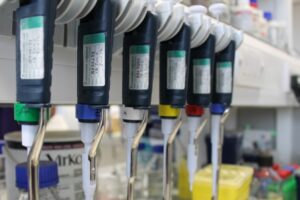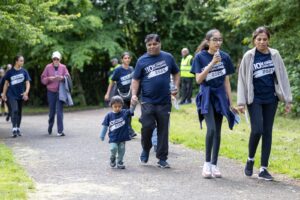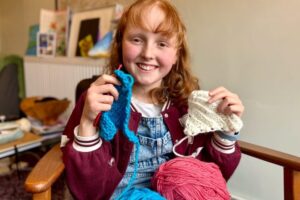Q&A with Professor Sibylle Mittnacht on her osteosarcoma research discovery
Children with Cancer UK has a history of enabling ground-breaking research that investigates all forms of cancer in children and how they can be treated. One such example is the recent work carried out by Sibylle Mittnacht, Professor of Cell and Molecular Oncology at University College London (UCL) Cancer Institute.

Sibylle and her team have dedicated the last 3 and a half years to their study, and have made an exciting breakthrough with osteosarcoma, the most common form of bone cancer in children, that affects approximately 30 children and their families in the UK every year.
We caught up with Sibylle to find out more about her work, and what her research hopes are for the future. She writes:
Q: Can you tell us about your recent research?
Our research provides evidence that a group of osteosarcoma (bone cancer) patients may respond to molecularly targeted anti-cancer drugs, called PARP inhibitors. These are currently used with notable success in adult patients with ovarian cancer. PARP (poly-ADP ribose polymerase) is a protein found in cells, and it helps damaged cells to repair themselves, therefore inhibitors stop repair that is specifically needed in certain cancers, for them to survive.
The PARP inhibitor drugs have very few side effects, and can be taken over a long period as a so-called “maintenance treatment”. Because of this, they can likely kill dormant (“sleeping”) cancer cells that may have migrated to other parts of the body once these regain division activity and then cause disease to re-occur.
We believe that replicating the treatment strategy already used in ovarian cancer in osteosarcoma patients may prevent deadly disease relapse that currently cannot be treated or prevented.
Q: Why is it so important to find new treatments for Osteosarcoma?
It is indisputable that a seismic improvement for osteosarcoma patients has come from high-dose chemotherapy, which has increased survival from less than 30% to near 70%.
However, one in three young osteosarcoma patients still die from cancer despite current treatment, and a solution must be found for them.
Importantly, patients, even if they do survive, pay a high price for the potential benefit of the current high dose chemotherapy regimen, often resulting in poor quality of life during treatment because of debilitating side-effects, and secondly a high incidence of long term damage in different organs.
It is these two problems that identify a clear need for more, and different, treatment options in addition to what we currently have! It is important to find alternative treatments that are effective, but kinder than our current treatment options.
One in three young osteosarcoma patients still die from cancer despite current treatment, and a solution must be found for them.
Q: What can your new discovery potentially mean for children and young people diagnosed with Osteosarcoma?
We anticipate that the potential new treatment could be used to prevent disease relapse for patients whose chemotherapy treatment isn’t effective long-term. With this additional treatment, we believe that the chance of survival is greater.
While our work shows high-level sensitivity to PARP inhibitors, which is linked to a specific genetic change in osteosarcoma, this notion at this moment is based on preclinical work, which is based on models of human osteosarcoma in the laboratory. While this is significant, we believe that the essential next step is testing the ability to improve disease outcome in a clinical study. It is vital to get this underway as quickly as we can so that we can start putting the treatment into place.
Q: What are you hoping that your research will lead to in the short to medium term?
In the short term a pan-European clinical study so that this research can be tried and tested. It will have to be a larger study than feasible in just the UK as it is otherwise not possible to get sufficient evidence on this rare type of cancer.
My team will seek to continue working on osteosarcoma. As a by-product of our studies, we have gathered evidence that we hope will allow us to make an inroad to predict chemotherapy response. Additionally, we are looking at other drug groups that seem to yield response in cases where the current chemotherapy drugs do not.
A very strong wish would be that, over the coming years, we will see a change in the outcome so that more patients diagnosed with Osteosarcoma will live a full life.
Q: What inspired you to become a scientific researcher?
The thrill of discovering how life works, and to gain a glimpse of how this is challenged by disease and, of course, the hope that if we understood this latter, we could do something about it.
Q: What do you hope will be the ultimate outcome of your research?
That we can use the word ‘cure’ in cancers like osteosarcoma more frequently and with more certainty, and that our work will identify viable, robust routes that regularly save patients’ lives.
Q: What has been the highlight of your career so far?
There is no simple answer here, but highlights are when my research makes a difference including where it establishes concepts that change the way we think about a problem. Highlights are also where our conceptual work can be transformed into viable patient treatment.
A true and indisputable highlight will be if this new discovery we’ve made translates into the clinic, as we very much hope, which would result in saving the lives of young patients.
Find out more about Professor Mittnacht’s recent research discovery.
We anticipate that the potential new treatment could be used to prevent disease relapse for patients whose chemotherapy treatment isn’t effective long-term. With this additional treatment, we believe that the chance of survival is greater.
Other stories
We have lots of information to help you learn more about childhood cancer. From specific cancer types, to treatments and causes.









